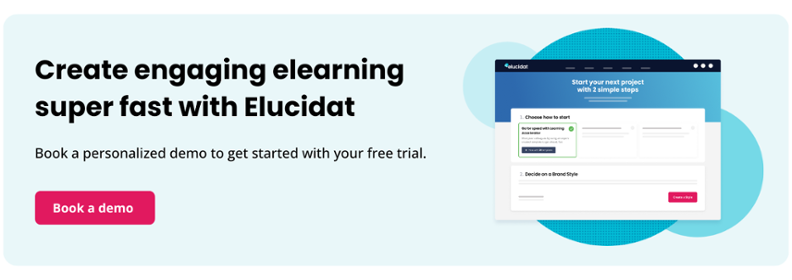10 best online training platforms for employees
12 minute read
The transformation of the modern workplace continues at pace. Whether you’re a large business or a smaller enterprise, your employees are unlikely to be based in one office, city, or country. Getting everyone together in a classroom isn’t feasible. Unless it’s a virtual classroom, of course. This is where corporate elearning solution comes in. But how do you pick the right platform for your organization? Read on to explore the best online training platforms for employees.

What is an online training platform?
There’s no shortage of great tools and technology to help you deliver digital learning. But finding the perfect platform or a bespoke elearning solution for your people isn’t easy. If you dive straight in, you could quickly get lost amongst the wide range of options (not to mention all the acronyms). So, before you explore the available online training tools, you need to get clear on what an employee learning platform means.
An online employee learning platform is software that helps companies digitally deliver employee training programs. From onboarding new hires to compliance training, these tools are designed to create, host, and/or deliver digital learning courses and other training materials. This enables your employees to access learning and professional development whenever, wherever, and at their own pace.
Types of online training software for employees
There are lots of different software available for training employees, but we’re going to focus on the three main types of elearning platforms:
- Learning Management System (LMS): Learning Management Systems are platforms that allow you to host and deliver learning, track your learners’ progress, and analyze basic data about your training (such as its completion). With an LMS, you can manage various online and traditional face-to-face learning experiences. However, if you want to create an elearning course to sit on your LMS, you will also need an authoring tool.
- Learning Content Management System (LCMS): An LCMS combines some of the functionality of an LMS with authoring tool capabilities. It enables you to create, as well as host, manage, and deliver learning content (often via an elearning portal). As LCMSs tend to focus on digital content, it means they can track these online learning experiences in much more detail than an LMS. Detailed analytics can include time spent in a module, the device used, and much more.
- Learning Experience Platform (LXP): Like an LMS or LCMS, an LXP hosts learning content for employees. However, rather than the content being assigned by a Learning and Development (L&D) team, the learner discovers the content for themselves. It offers adaptable learning paths through your online courses and curated and user-generated content. Some LXPs also use Artificial Intelligence (AI) to learn about the employee’s needs and preferences.
Benefits of online training platforms for employees
Whichever type of platform you decide on, you’ll find there are plenty of benefits to using online training software for employees’ development.
- Reduced training costs: Moving to an online elearning platform pays off. Increasing your capacity for online learning reduces your need for more expensive face-to-face courses. Add elearning authoring into the mix, and you can also avoid using more costly agencies to produce your learning content.
- Easy to access: Employees can log on to your platform wherever and whenever. That means they can complete digital learning at their own pace. If a skill gap appears, they can even do some training on the job. Easy to fit into and around work, digital learning can also reduce the time they need to spend away from their everyday duties for training.
- Increased impact: When we surveyed learners, 62% said relevant content was the most important factor when it came to the effectiveness of elearning. Employee learning software with content creation capabilities allows you to start developing elearning solutions in-house. Say goodbye to generic off-the-shelf content, and start meeting changing employee development needs with relevant digital learning.
- Standardized: When you can’t get people together in a room to train, it’s difficult to ensure they’re on the same page. An online learning software allows you to roll out employee elearning courses across locations. So, you can create consistent skills and knowledge across your business and globally.
- Empowered employees: With access to an online platform full of great training modules, it’s easier for employees to take responsibility for their own development. They can select from a range of online training and personalize their learning experience. Powered by AI, some LXPs can even learn about and predict their learning needs. Serving up relevant content before your learners even know they need it.
- Tracked: An online training software enables you to easily manage and monitor the rollout of digital learning to large numbers of employees across locations, sectors, and departments. This doesn’t just allow you to monitor the progress of employees. It also provides an audit trail that can prove compliance with regulations.
- Continually improving: Feedback, data, and analytics from your employee learning software allow you to understand whether your training is meeting your business needs. By interrogating this information, you can find out what is and isn’t working so you can adapt and improve your approach.

What to look for when choosing an online employee training platform
Online employee training tools can offer plenty of benefits, especially those integrated into a business training platform. But if you’re going to maximize the impact, you need to make sure you choose a platform that’s right for your business.
Step 1: Get clear on your requirements
Before you get too deep into your research, take some time to get clear on your key requirements. For example:
- What type of training will you need to deliver on this platform?
- What quantity of digital learning content are you aiming to deliver in a given time frame?
- What is the level of skill, experience, and availability of your team for managing this platform? Will they need training and support?
- What other training systems will this platform need to integrate with?
- Do you have a set budget for implementing the platform? And what would a good return on investment (ROI) look like?
Step 2: Focus on key features
With a clearer understanding of what you’re trying to achieve, you can start to consider how an employee learning platform can best meet your needs.
Here are some things to look for in the online learning platforms that you’re considering.
Ease of use: Evaluate how easy it is to use the platform – both from the end user’s and administrator’s point of view. What support is available to help you and your team get up and running? Consider all the ways you will use the platform. For example, creating content, assigning training, and checking completion, to name just a few.
Key considerations:
- Ease of accessing and using the platform for the end user
- Level of skill and experience required of administrators
Scalability: Explore how the platform can help you efficiently deliver the quantity of digital learning you need. Find out if there are any limitations to the number/size of online employee training courses or their storage. Consider the number of employees and administrators you’ll need using the platform.
Key considerations:
- How easily can you create and/or deliver digital learning at scale
- Cost-efficiency that can be achieved by simplifying or automating any processes
Technical capabilities: It’s unlikely that this will be the only tech you use. Find out how easily and effectively the platform can integrate with your other systems. Explore how responsive the platform is (e.g. whether it has a mobile app). Find out how it uses, gathers, and presents data so you can measure your success.
Key considerations:
- Integration with your existing tools and any related requirements (SCORM compliant? xAPI enabled?)
- What kinds of data can be collected and how this will be presented
Quality: Ask the provider for a demo to understand whether this platform will deliver quality learning experiences. Understand the look, feel, and usability that can be achieved. Gauge the types of learning experiences that can be created and/or delivered.
Key considerations:
- Whether look and feel can be adapted to your brand(s)
- Variety of effective learning experiences that can be created and/or delivered
Maintenance: Find out how easily and quickly you can update digital training. Explore what impact any changes or new versions can have, such as loss of completion status and data.
Key considerations:
- How easy and quick it is to update your elearning content
- Any knock-on effects of adding new versions of content to the platform
People behind the tool: When investing a lot of money into a platform, you want to be sure support will be on hand when needed. Will the provider support you through implementation? Does this support continue when you’re up and running and it’s business as usual?
Key considerations:
- Will you have a customer success or support contact
- Are there any other services on offer (such as consultation on your digital learning strategy)
Step 3: Create a list of key features
It’s unlikely that you’ll find one business training platform that ticks every box. So, you need to decide on your priority features. For example, is it more important that the platform is easy to use or has more advanced technical capabilities such as training needs analysis tools? Do you need a mobile app, or will most employees access learning on their desktop or laptop? Put together a list of must-haves and nice-to-haves.
Step 4: Evaluate each platform
Armed with a list of priorities, you can do some research to identify tools that appear to meet these key needs. Once you have a short list of the platforms that you think could work for your organization, you should:
- Check out reviews (on trusted sites like elearning Industry) and comparison articles
- Explore any customer testimonials to understand people’s real-world experiences of the platform and partnering with the vendor
- Ask for a demo and sign up for free trials so you can try the things out for yourself
- Weigh up the value for money and ROI each platform could offer
Save time comparing tools with this handy authoring tool comparison template.
Step 5: Make the business case
When you’ve identified the platform that comes out on top, it’s time to share your decision. Discuss it with your team and any key stakeholders to get their thoughts and feedback.
Once everyone is happy with the decision, you may need to make a formal business case. This provides the rationale for investing in your chosen online learning program. It serves to convince budget holders and stakeholders of the business benefits of this purchase. If you’re going to make a compelling case, you need to do it in their language and show it aligns with the wider business priorities.
Find out more about how to implement an elearning authoring tool successfully.
10 best employee training platforms
Ready to start your research? The employee elearning platform market can feel like a complex place. Before making a decision, it’s important to fully understand all your options and thoroughly review any possible candidates.
To get you off to a good start, we’ve compiled an overview of some of the best employee training software platforms and why you might choose them.
LMS
- LearnUpon – A customer-centric learning management tool with an easy-to-use interface
LearnUpon is a cloud-based LMS with a focus on the end user – both the learners and the L&D teams. A user-friendly interface makes it easy for both admins and learners to get the most out of LearnUpon. Customer feedback influences the product roadmap and shapes the platform’s development.
- Docebo – An LMS platform combining innovative tech and methods to support different learning styles
Docebo Learn is an easy-to-use and configurable cloud-based LMS. By using different learning approaches and the latest technologies, such as social learning and AI, Docebo supports the different ways that people learn. Its pricing model is based on monthly active users, which can mean Docebo is an affordable option.
- Cornerstone – A holistic solution to learning management that offers world-class support
With Cornerstone’s corporate LMS, everything related to employee training and development is found in one place. This holistic solution enables you to manage different formats, including face-to-face workshops and informal development, as well as multimedia video, audio, and VR learning content. Cornerstone’s world-class customer service means the platform implementation is fully supported.
- Litmos – Globally popular employee training software that easily integrates your content
Litmos is a digital training software used by many major corporations worldwide. It offers tools to easily integrate a training library with your systems and measure progress among learners through assessments.
LCMS
- Elucidat – Empowers big employers to deliver impactful and scalable elearning experiences.
Elucidat started life as an authoring tool, but over time has developed a much broader set of key features to enable collaboration, hosting and delivery. Elucidat is designed for scalability. With Elucidat, you can build, review, and deliver all in one place. Cloning your course makes reuse, rebranding, and translation simple. And keeping a parent course avoids version control issues. While not technically a full LCMS, Elucidat is still a great option.

- EdApp – An all-in-one training solution and LCMS that focuses on microlearning
EdApp is a LCMS workplace training solution. The package includes an admin portal, learning portal, and analytics suite for smooth and effective learning delivery. Its creator tool includes an editable course library and features – like microlearning, gamification, and spaced repetition, as well as AI course creation and translation.
- Xyleme – An elearning platform that brings the entire elearning together in one place
Xyleme is a comprehensive elearning platform and LCMS that brings the entire learning content management lifecycle together in one process. Xyleme provides a single source of truth by streamlining content authoring, publishing, updates, delivery, tracking, and analysis into a collaborative platform.
- iSpring Learn – An intuitive learning platform interface with basic authoring capability
iSpring Learn is an LMS with simple content creation capability. Its intuitive interface makes it easy to find training content on any device (and even offline) using a mobile app. Its authoring tool is PowerPoint-based. It’s a great option for novice learning designers who don’t have to worry about updating content regularly.
LXP
- Valamis – An elearning platform and LXP providing end-to-end capabilities
From learning creation to management and delivery, Valamis is an elearning platform and full learning ecosystem. It’s an LXP first and foremost, but as a package, it also comes with an LMS and basic authoring capabilities, which give it an edge over other LXPs.
- Degreed – An LXP connecting learners to resources they need
Degreed integrates new skills insights and different types of people development to connect learners to the resources they need. It also provides learner insights with analytics so organizations can collect, understand, and build skills for greater impact.
Want to find out more about these platforms and explore other tools? Download our authoring tool comparison template or read our full online training tool review.
Summary
The modern workplace has changed the way we deliver training. An online employee learning platform is now a must-have tool. It gives your employees easy access to relevant and effective learning materials wherever they are. But if you’re going to maximize your impact, you need to make sure you choose the right platform.
Training employees online with Elucidat
LMS, LCMS, or LXP? Each type of platform offers different benefits. But you’ll need an LCMS if you want to combine content creation and delivery. With Elucidat you can do just this and a lot more. New authors and experienced designers can create impactful, responsive elearning programs that meet your standards.
Efficient workflows mean multiple authors and reviewers can work on a project simultaneously. Publishing and releasing online courses is easy. And once your course is being used, you can track employee engagement at page level. So, you can gain insight and iterate your online learning content on an ongoing basis. After you update your course, you can re-release without worrying about version control issues and any data loss.
And just as you’re empowered to iterate your elearning, Elucidat is constantly improving. Whether it’s streamlining your feedback collection process or auto-translating, you can maximize the impact of implementing staff training software with Elucidat.
Want to see for yourself? Book a demo of Elucidat to get started with a free trial.




